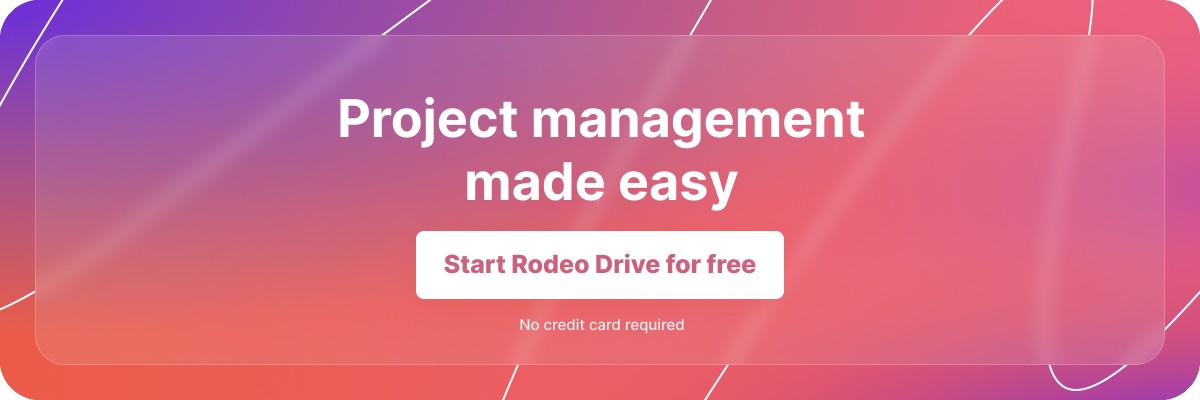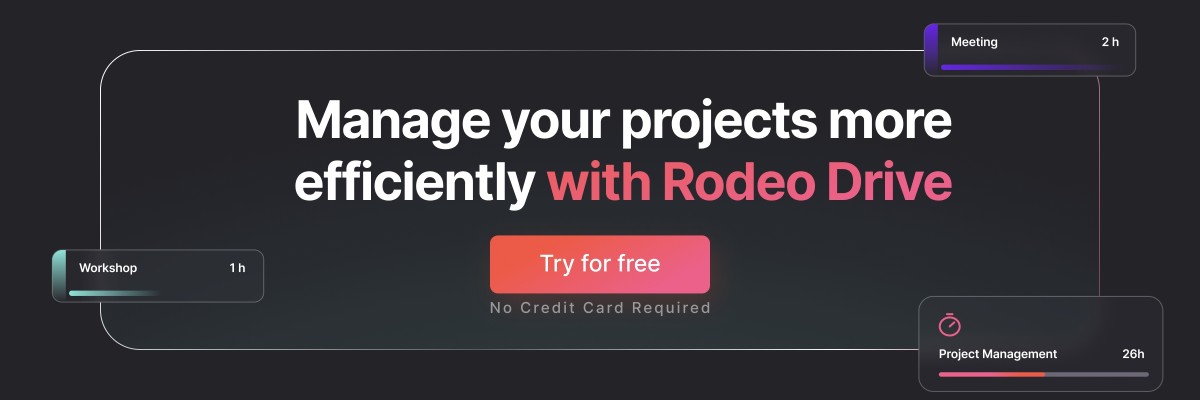ChatGPT in Project Management: How to Get the Most Out of It
It’s difficult to go anywhere online these days without being bombarded with information on the rise of AI and ChatGPT. But a big question still remains — how will machine learning tools transform project management in the near future?
The answer to this question is still unclear, but what we do know is that many project managers are already using ChatGPT to speed up some of their project management and administrative tasks.
But although the tool is rather simple to use, knowing how to use it effectively is the best way to get the most out of it. In this article, we’ll introduce you to some ways it can improve your project management processes as well as some best practices.
AI in project management
With the widespread availability of ChatGPT, many in the project management industry are wondering how AI will begin disrupting the status quo in the near future.
Harvard Business Review recently outlined 6 areas of project management that are likely to be transformed by AI, including project selection, risk assessment, and less reliance on administrative work.
The thought is that with a machine learning model that has a large amount of project data inputted, it’ll be able to identify which projects have the greatest likelihood of success, allowing organizations to only take on the projects they know will benefit them most.
Additionally, artificial intelligence will be able to help project managers assess the likelihood of various project risks and help identify potential issues that they might’ve otherwise not noticed. Having the ability to automate some of these processes will obviously have huge benefits for project managers, and it will likely change the nature of their role significantly.
The biggest question at large is whether the project manager role will be altogether replaced by AI, which we’ll dive into later on. But at a very minimum, project managers can expect their role to demand a different skillset, as much of their administrative work may very well be replaced by AI tools.
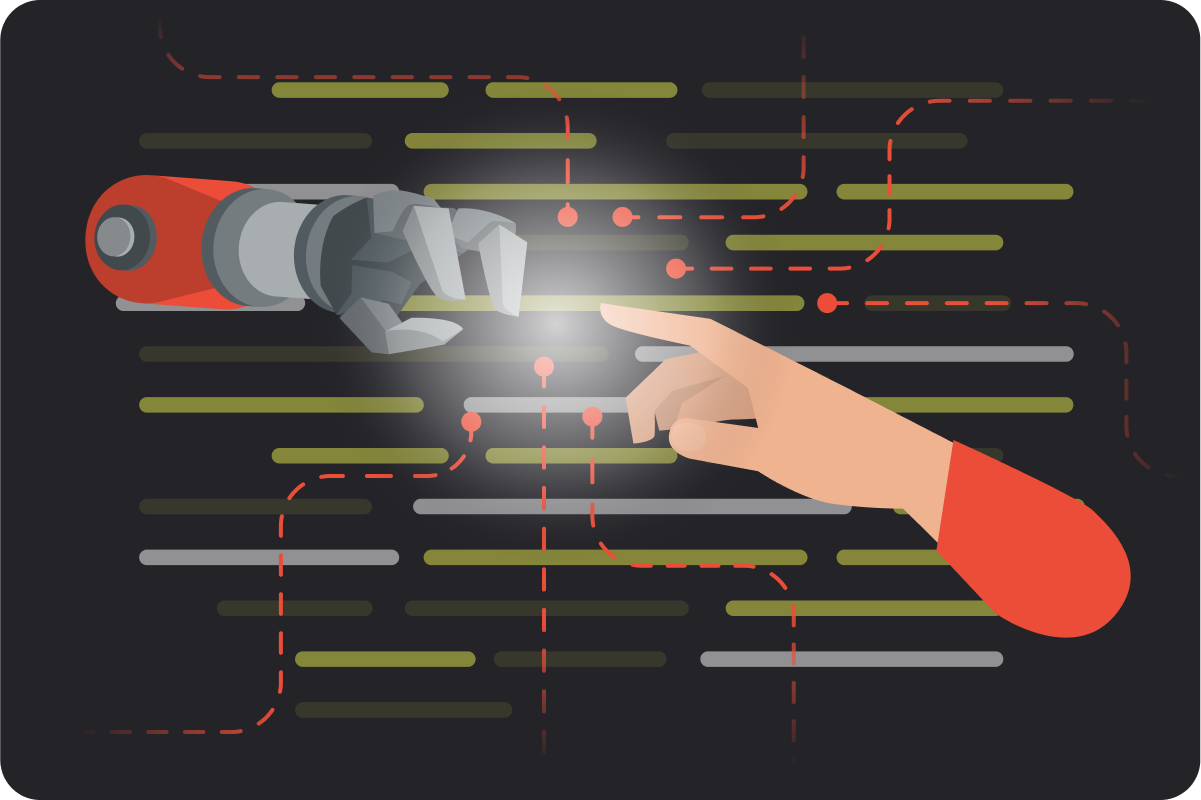
Understanding ChatGPT: What is it really?
ChatGPT is a type of large language model that can engage in human-like interactions to assist with things like troubleshooting, writing, and predicting project outcomes.
The tool has endless uses, which is why it’s taken the world by storm recently. In fact, ChatGPT became the fastest-growing consumer application in history when it surpassed 100 million active users in January — just two months after launch — according to Reuters. In comparison, it took Instagram 2.5 years to reach the same user base.
As a large language model, ChatGPT was created with an input of 300 billion words across a 570GB dataset. Using its vast amount of data, the tool is able to predict the next word in a sequence of words to give you a response to your prompt that’s fitting for what you’re looking for.
If you’ve never used ChatGPT, it’s actually quite simple. You can ask it a question and it will immediately provide you with an answer. All you need to do is create an account with OpenAI, the artificial intelligence company that owns ChatGPT.
Can we use ChatGPT for project management?
You can absolutely use ChatGPT for project management. In fact, many project managers are already using the tool.
A recent Reddit poll in r/projectmanagement found that 53% of project managers are using AI in some capacity. The use cases for poll respondents vary widely — some are using it to write job descriptions or draft company policies which can be time-consuming.
The overall thought behind using AI in project management is to save time on mundane tasks. Later on in this blog, we’ll detail more ways that project managers can leverage ChatGPT.
Interested in using ChatGPT for marketing projects? Check out our article with 70 marketing prompts.
Will AI and ChatGPT replace project managers?
Currently, artificial intelligence tools are not advanced enough to completely replace the project manager role, and it’s difficult to predict the extent to which it’ll replace the position in the future.
Several studies are being conducted that aim to predict how AI will change project management, but nothing is conclusive.
Research group Gartner estimates that 80% of today’s project management tasks will be eliminated by artificial intelligence by 2030, although AI technology will need to significantly progress in order for this figure to come to fruition.
In terms of ChatGPT, you need to be skilled in writing prompts that will actually get you the response you’re looking for. Many people still have yet to master the right prompts, which is another factor that prevents AI tools from replacing project managers altogether.
After all, if your client isn’t always clear on what they’re looking for, then they won’t be able to concisely convey what they want to an AI tool, either.
ChatGPT strengths and limitations in project management
One of ChatGPT’s main strengths is the humanness of its interactions. It can generate short pieces of writing that easily sound like something a human could’ve written.
Plus, its vast knowledge base allows it to answer questions on millions of different topics, all personalized to your specific needs. Should one of its responses not answer your question, you can simply add more detail to your prompt and have it try again.
However, the tool is certainly not without its limitations, and bias is a major issue with ChatGPT today. Because ChatGPT is responding to your prompt input, it’s not uncommon to receive a response that’s offensive or false. However, subtle forms of bias in its responses may pose a larger issue.
For instance, in this article, the writer asked ChatGPT to write two job posts for a marketing position — one targeting candidates who attended Howard University, and another for Harvard University.
The tool’s tendency for implicit bias was clear in the responses generated for each university. The responses for Howard — which is a historically Black university — mentioned that candidates should have a passion for diversity and inclusion, whereas the Harvard responses expected candidates to have analytical skills.
The idea that Howard students should excel in inclusion over analytical skills is certainly a stereotype and one that ChatGPT was unable to exclude from its outputs. This type of bias was also evident in performance reviews that ChatGPT generated for people from each school.
Future versions of ChatGPT may be more effective at preventing biases in its responses, although as a large language model, ChatGPT is only generating responses based on the inputs it's given, which certainly aren’t bias-free.
6 ways project managers can benefit from ChatGPT
Project managers can benefit from ChatGPT in any areas that are currently clogging their workflows and causing them busy work. It can be useful within any of the five project phases, whether that’s project planning, initiation, execution, monitoring, or closing.
Here are 6 use cases that are all possible in the existing version of ChatGPT:
1. Summarization
One of the most handy things the current version of ChatGPT can do is summarize long pieces of content and condense them into a short summary. Project managers can find multiple different use cases for this — one of which is creating a summary of meeting minutes.
You can do this by either entering your detailed meeting minutes into ChatGPT or even by pasting your entire meeting transcript into the software and asking it to sum up what was discussed. After some minor edits, you’ll have a summary to share with other team members or even your client.
However, be aware of potential security risks that might come with inputting proprietary information into an artificial intelligence tool. You can’t be positive about what AI-powered tools will do with your information after you receive your response, so it’s best to redact the sensitive parts of your project before submitting.
2. Status report templates
Not only can you use AI to create project reports, but you can also use it to help format the status updates you send to clients or stakeholders.
This might be helpful when working on large projects that come with a plethora of information, as it can be difficult to decide on what’s important enough to include. Instead, you can ask ChatGPT to create status report templates for your project that help you parse through everything.
Related: Leveraging Real-Time Reporting: A Comprehensive Guide
From there, you can pull data from your project management software and input it into your template. All-in-one project management tools like Rodeo Drive make things easy, as Rodeo Drive automatically compiles your reporting data based on your team’s usage of the platform.
Below is an example of Rodeo Drive’s employee productivity report, which can provide valuable insights into your team’s billable hours, allowing you to understand how much of their project workload includes non-billable time.
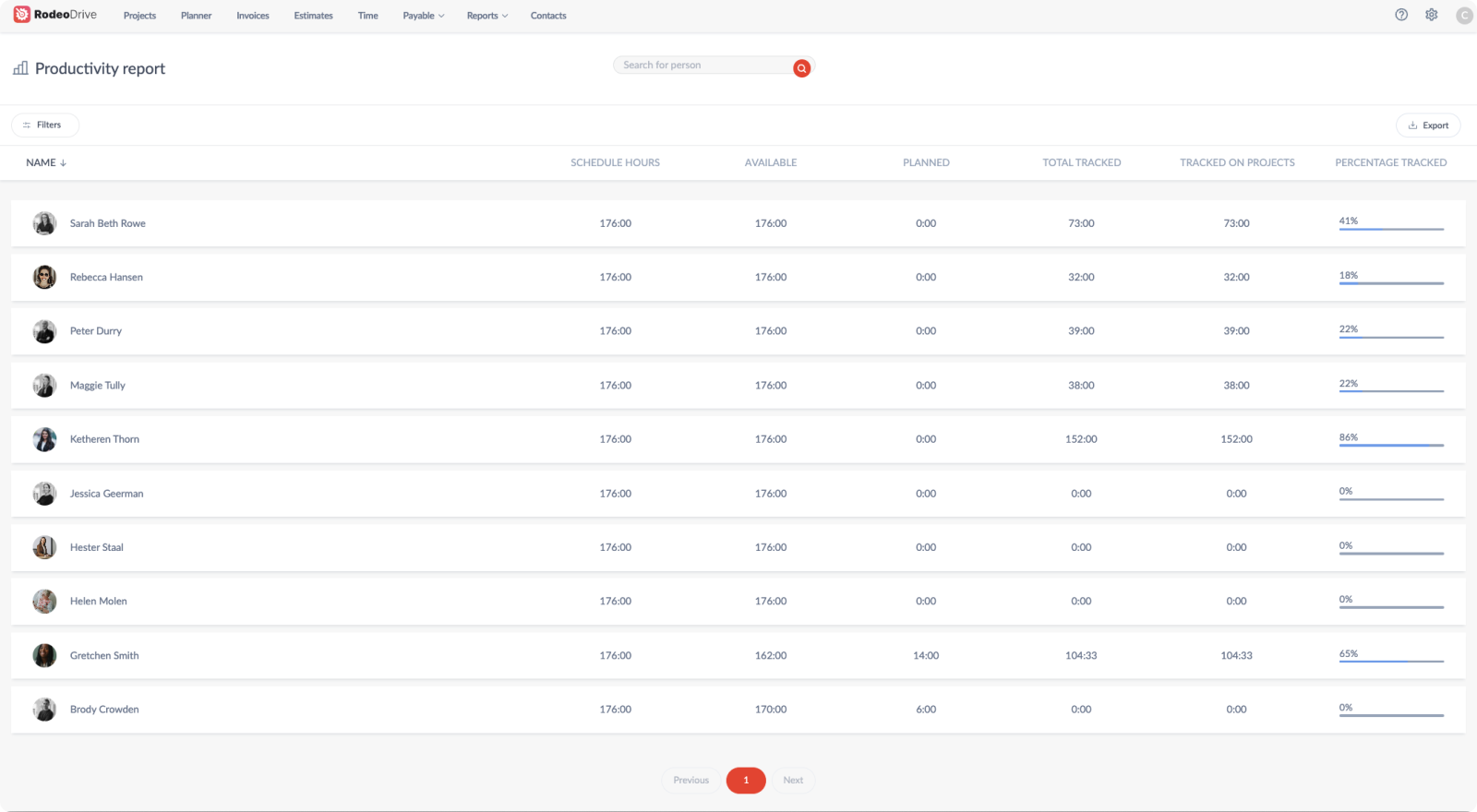
3. Writing emails
Emails can be a major time suck for project managers who have a million other responsibilities on their plates. Instead of spending time agonizing over creating a perfect first draft, ChatGPT can write one for you.
While you probably won’t want to send ChatGPT’s draft as is, it can be a great jumping-off point to get your message across. Then, you can spend less time ironing out the details and getting it ready to be sent.
4. Information gathering
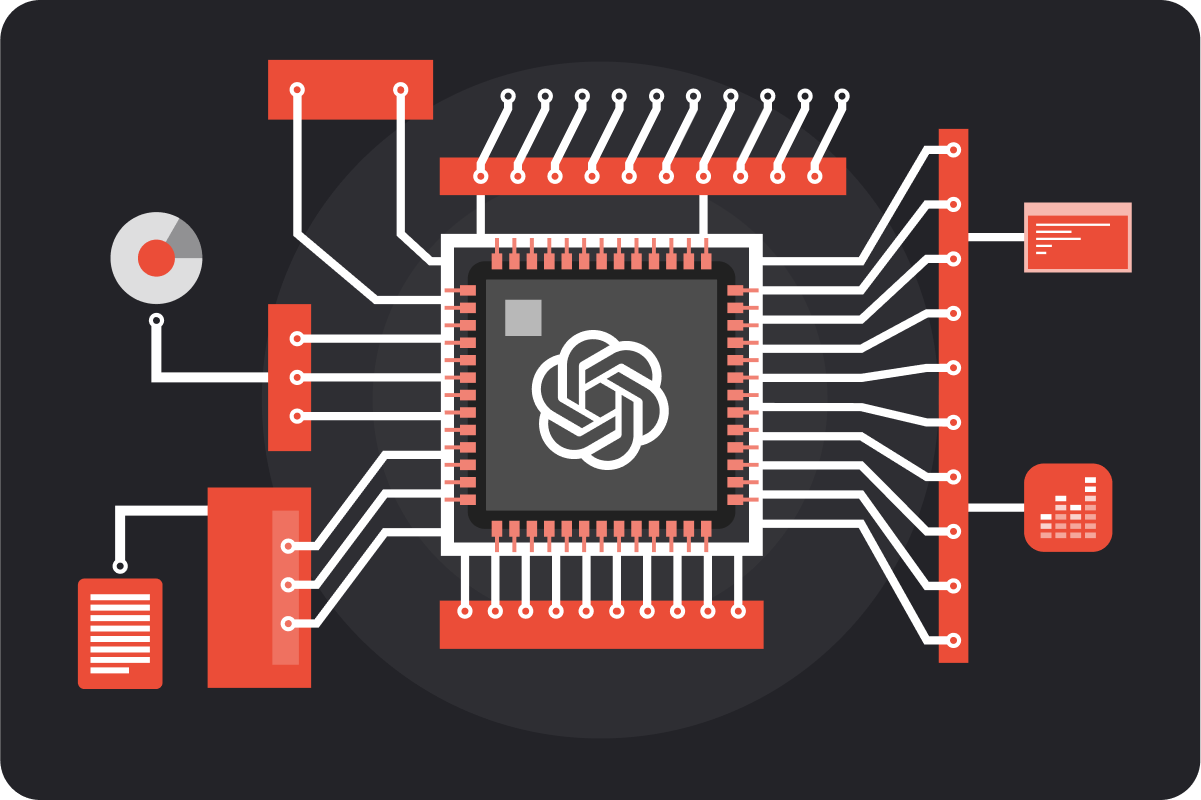
When you’re working on a project in an industry that’s new to you, you’ll likely need to invest a significant amount of time into familiarizing yourself with industry statistics and data.
Although ChatGPT doesn’t have access to updated real-time data, it can still provide you with information that’s somewhat recent, along with sources that you can further investigate.
In the example below, you can see that ChatGPT is able to provide data up to September 2021. Its responses also include where it got the statistics from, which can be a great resource for further information gathering.
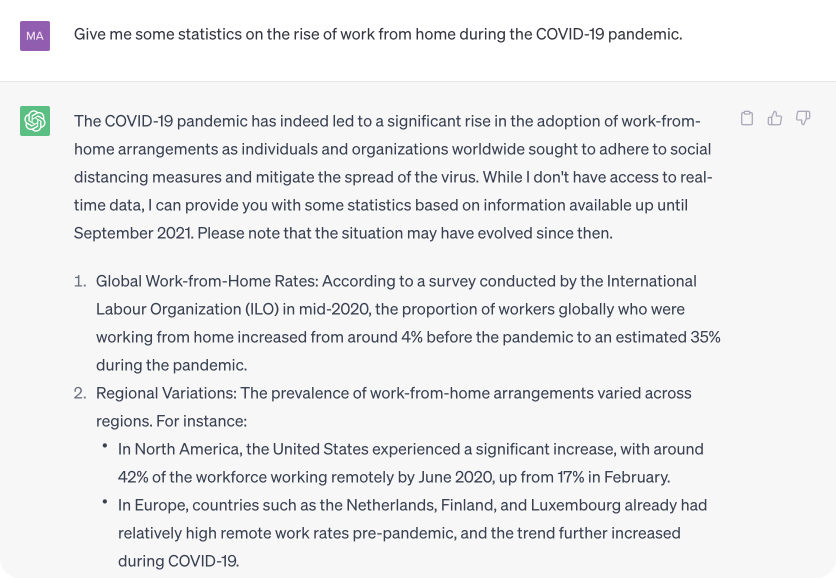
5. Building arguments against your ideas
Although you might think that your ideas are great ideas, your client and or stakeholders may not always agree. Luckily, you can ask ChatGPT to come up with arguments against your ideas, which can help you identify your weaknesses in your main points.
This can help broaden your line of thinking, introducing you to a perspective you might not have considered before. That way, when it comes time to present your ideas to stakeholders, you can be sure your arguments are solid.
6. Creating tasks and descriptions
Project managers — just like all humans — can sometimes be forgetful. But sometimes forgetting to add a particular task to your team’s calendar can cause major setbacks that can interfere with your team’s ability to complete their work on time.
Asking ChatGPT for a list of tasks that you’ll need to complete for a particular project activity is a great way to check that you haven’t forgotten anything. See below for an example of how a marketing project management team might do so.
Or, if you find yourself spending a lot of time assigning tasks to your team members, you can use ChatGPT for a little extra assistance in writing up the task description you plan to hand off to them.
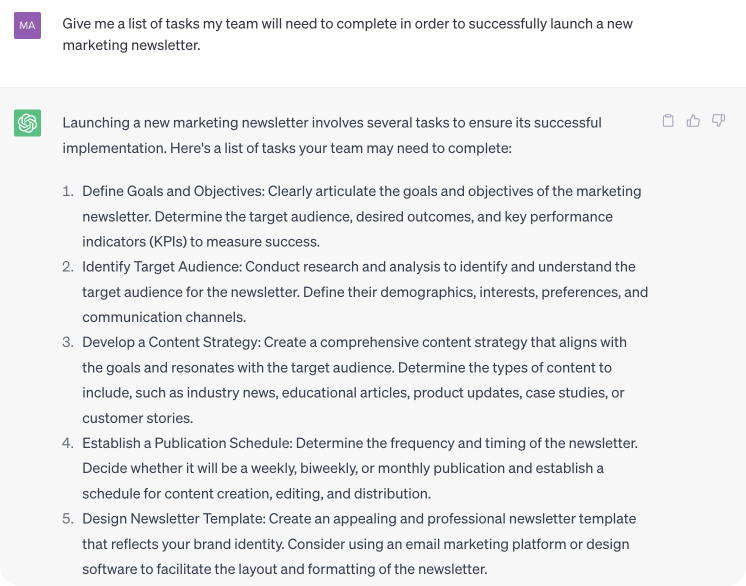
While AI can help you brainstorm the project management tasks your team will need to complete, you’ll still need to utilize a project management software tool like Rodeo Drive to keep everything organized.
Related: 12 Ways to Upgrade Your Task Management Skills
Project management software solutions serve as a centralized place to plan and assign tasks, manage deadlines, and get real-time status updates on your team’s progress.
For instance, Rodeo Drive allows you to create tasks and plan when your team will work on them. Need to move a deadline? No problem. Simply drag and drop the task.

Best practices for ChatGPT
ChatGPT can certainly help streamline your project management processes, although the output you receive from the tool will only be as good as your prompt engineering skills.
Writing quality prompts is an art, and familiarizing yourself with how to do so can have a measurable impact on how you manage projects. Here are a couple of basic best practices you’ll want to implement:
Be specific
Specificity is crucial when working with any tool that uses machine learning algorithms. Unless you’re clear about what you’re looking for, you’re likely to get an irrelevant response. Add as much context as you can in order to get your desired outcome.
For instance, if you’re looking for some assistance with writing an email, consider adding a paragraph limit or word count to ensure that the response you receive won’t be too long.

Use the right keywords
Using the right keywords goes hand in hand with being specific enough for ChatGPT to understand what you’re looking for. Remember that the tool was trained on a dataset containing billions of words, so including keywords helps it narrow down its responses.
For example, if you’re looking to learn more about different project management methodologies, you might input something like: “Tell me about the different project management methodologies.”
While this may very well generate a helpful response, something like: “Explain the basic principles of the PRINCE2, Kanban, Agile, and Scrum methodologies” will probably yield a response that’s closer to what you’re actually looking for since you included specific keywords.
Ask follow-up questions
Sometimes you just don’t get the info you’re looking for on your initial request. But since ChatGPT allows you to engage in a conversation with AI, it’s easy to course-correct and ask follow-up questions that will get you the right response.
Using the example from above, let’s say the tool gives you explanations of Agile and Scrum that are extremely similar to one another. Instead of asking it to re-explain, a more productive follow-up question would be something like, “What are the differences between the agile and Scrum project management methodologies?”
This way, the tool will clearly understand your objective and provide a response that’s catered to what you want to know.
Takeaway
All in all, we don’t know what the project management landscape will look like in a few years as AI improves beyond its current capabilities.
But even with the tools at our disposal right now — such as ChatGPT — teams can improve the efficiency of their project management practices and cut out some of their time-consuming busy work.
Hopefully, by now, we’ve given you some ideas on ways you can implement AI at various points in the project lifecycle. Best of luck!





